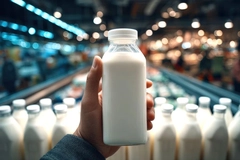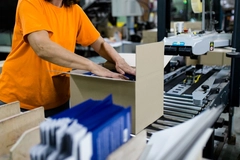Carrying The Can

Before 2005, Costa Coffee was using grey pulp board moulded trays, but it wanted a multi-cup carrier that was cost effective, eye-catching and environmentally sustainable. With PortaDrink, it felt the branding possibilities were huge.
13/07/07 Next time you pop into the supermarket to bulk-buy drinks, you’re unlikely to need a carrier bag. More often than not, when you walk out of the sliding doors you’ll be carrying a six-pack of beer, or a box of fizzy drinks cans, packed in cartonboard, complete with carry handle and mobile advertisement.
The hard-wearing pack that eases the transition of these bottles to your fridge is loaded with a message that brand owners feel only cartonboard can help them communicate. It is heavy-duty enough to hold weighty drinks and their bottles, but refined enough to convey a sleekly printed image and brand message. While the package protects your purchase, that brand name is displayed all the way to the point of consumption.
The market for cartonboard in such heavy-duty applications is rapidly growing, and highly innovative, according to Richard Dalgleish, managing director of the European Association of Carton and Cartonboard manufacturers, ProCarton. He says developments and investments in cartonboard are flourishing because of productivity improvements and more consistent quality over the past couple of years.
According to Dalgleish, the technical definition of cartonboard is a multilayer material made of three or more layers of cellulose fibre, weighing more than 160gsm.
Cartonboard that’s suitable for heavy-duty applications normally has a dense fibre composition, heavy grammage and significant thickness. Its high strength and stiffness in comparison to its weight is what makes it so popular, says Jonas Adler of Workington-based Iggesund Paperboard. Adler, an application specialist at the mill, says: “It is cheaper than other materials and it is also easily converted into the final shape of the product, so it has a high runnability.”
In general, Adler says solid bleached board (SBB) and kraft boards give very high tear-, tensile- and burst-strengths due to the pulp properties: “This is compared to folding box board (FBB), recycled board and, in some respects, corrugated.”
For carrying particularly heavy loads, a spokesman at Stora Enso says that cartonboard can be specially formulated. “Strength comes from how the board is made. The board needs to have a good tear resistance above all. It also has to have a good print surface as most packaging is printed on these days.”
Stora Enso currently has coated kraft back (CKB) board on the market. It has high tear strength, so it is suitable for products such as six-packs. It also has a high stiffness, so is suitable for solid cartons containing heavy bottles. Absolut vodka chose it for exactly this purpose, and produced multipacks of six-24 bottles from CKB board. Convincing factors in favour of CKB were good runnability on the bottling line, strength and an excellent printing surface. It was the print on the surface of its Foster’s cartonboard multipack that won brewer Scottish & Newcastle the Design Business Association Effectiveness Grand Prix Award in 2006. The design, by consultancy BR&Me, helped to grow sales of Foster’s by 36.4%. The print and design quality resulted in shoppers being able to find the Foster’s pack 20% faster than Carling equivalents.
The Stora Enso spokesman adds: “CKB is a kraft board, so it is robust and protects goods during transit and on shelves. We also have various FBBs, which are suitable for similar work.” This is a fully coated CTMP (chemi-thermomechanical pulp) board, primarily used as a top liner, so it must have good burst-strength, optimum flatness and shape as well as impeccable ply-bond, creasibility and surface properties.
Heavy-duty cartonboard packaging caught the eye of the judges at the 2006 ProCarton awards, when they awarded “Most innovative carton of the year” to Biermeter’s 12-bottle beer carry pack, made from MeadWestvaco board. The board is strong enough to hold 12 bottles of beer on one handle. “The amusing graphical design adds to the overall impact of the carton and the structural integrity of the carton was considered to be an excellent piece of cartonboard engineering,” judges said.
Long virgin fibres
Manufacturer Korsnäs reckons its Frövi Carry is a perfect example of an innovative cartonboard. It is a four-layer virgin fibre board with an unbleached bottom layer and a bleached, totally chlorine-free, clay-coated top layer. It has a high tear-resistance and strength thanks to its long virgin fibres, so it seemed the perfect choice for PortaBrands’ cup-carrying case.
Costa Coffee became the first nationwide chain to take on the PortaDrink concept in 2005. Since then, MSO Cleland, which prints and converts the packs, has created a special Comic Relief 2007 branded four-pint carrier. The pack allows many drink cups to be carried in one hand. PortaBrands has developed the concept to carry wine bottles and snack foods as well.
Before 2005, Costa Coffee was using grey pulp board moulded trays, but it wanted a multi-cup carrier that was cost effective, eye-catching and environmentally sustainable. With PortaDrink, it felt the branding possibilities were huge.
As well as engineering advantages, cartonboard is also recyclable. Developments in surface coating methods and board machine processing mean biodegradable polymers can now be extruded onto board instead of plastic laminates. The use of pulp bleached with chlorine gas has also been eliminated.
Materials recovered from the recycling process can be better sorted and used to their best advantage. ProCarton’s Dalgleish says 50% of all cartonboard produced in Europe is made with some recovered paper pulp. He adds that fractionation, which separates long and short fibres, is an important development. Long fibres can be extracted to make more robust recycled board and smaller fibres left for lighter grades.
Iggesund’s Adler says that recycled cartonboard materials can be formulated with high moisture-resistance properties, making them less likely to fail in strength-demanding applications. With these, he says that the bulk is lower than with FBBs and corrugated board, thus stiffness is better: “We tend to say FBBs give higher yield and recycled does not give strength or stiffness, though this depends on the origin of the recycled fibres. There are recycled boards that have quite high burst-strength.”
With consumers demanding packaging that is strong, protective, easy to handle and environmentally sound, it seems there’s nothing like heavy-duty cartonboard to deliver the goods.
TEARING STRIPS OFF ITS RIVALS
When a tear-strip works, it’s a great way to easily open a cartonboard pack. “Far too often it doesn’t. The consumer gets annoyed and the brand owner pays the penalty,” says Karsten Thurling, who is responsible for a tear-strip project at the Technische Universität Dresden, working with Anna Jansson, laboratory engineer at Korsnäs’ PackLab.
“There is no real research done in this area, so the method used by the packaging designers is simply trial and error for a certain material. If the converter then changes material, the problems start,” says Jansson. Together, Kornsäs and Dresden university have designed a study that will investigate what happens in the opening moment with different cartonboard materials.
The focus is on how the tear-strips react in the opening moment on different board materials, with different numbers of layers, and which construction is best suited to which material. Speed and angle are other parameters that will be tested.











